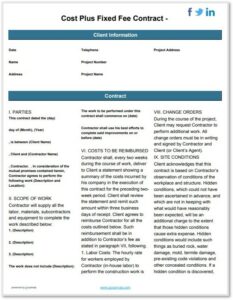The Ultimate Guide to Construction Contracts [Examples + Templates]
No contractor and no client should begin a substantial construction project without a contract. What does “substantial” mean, here? First, that the complexity and duration of the project leave room for disagreements about the scope of the work. Second, that the amount of money involved for both the contractor and the client warrant legal protection.
The essence of a construction contract is often described as the contractor and client “being on the same page” about the project. That means the scope of work, timetable, payment, payment schedule, quality of work, penalties for late completion or late payment, and emergency situations.
Creating a contract with a client, and getting approval, take time. But it is safe to say no time is ever better spent on a construction project. What follows is a description of what a construction contract should include, why different types of contracts fit different projects, and some required details for any contract.
What is a construction contract?
A construction contract, of course, is a legal document. It can be enforced in a court. It outlines the scope of a project, the agreed-upon payment, and how to handle unexpected developments. Because the contract states objectively what both parties agree on, it represents a layer of protection as important to the contractor as to the client. Every contractor has run into a demand for work, without additional payment, that was not included in the original plan and run into arguments about the schedule of payments.
A contract has two great virtues:
- It enables the work to begin with the client and contractor “on the same page” about what has been agreed.
- It defines the legal recourse of each party if during the project they are not on the same page.
Types of construction contracts
There is no single type of contract for all construction projects. For example, a contract for a residential client will look different from a contract for a commercial client. But for any client, there are contracts with different structures that largely depend upon now payment is calculated. Here are the four most common:
Lump sum/fixed price: The client asks “How much will it cost?” and wants a single figure or lump sum for the entire project. This provides the client with an assured expenditure they are ready to accept; it provides the contractor with an incentive to get the project done fast, done right. But contracts allow for contingencies. What if the contractor finishes before or after the completion date? Is there an incentive for the former and a penalty for the latter? The contract should specify that.
Cost plus: This means that the client agrees to pay all costs of the project and, on top of that, a fixed amount or percentage of cost for the contractor’s profit. Often, this is viewed as full protection for the contractor, but it also can produce a project cost that does not include a contractor’s “just cover myself for any problems” boost in the fixed price.
Time and materials: In this type of contract, payment is tied to an hourly or daily rate charged by the contractor and actual costs for materials. But consistent with the principle of a contract, clients pay additional, unexpected costs that arise during the project. One may be the contractor’s overhead or the contractor’s markup on materials the contractor obtains.
Unit pricing: Unit pricing contracts view the project in terms of measurable units—the type of task or its scope or work and the materials required.
The construction contract that is best for you, for the type of project, and for your client, depends largely upon how the contractor and the client want to structure payment.
The essentials for your construction contract
Any type of construction contract for your project will have certain key elements:
Identifying/Contact Information
Who is entering into this agreement?
For the client, that means a name (or business name), phone number, email address, and the specific location of the property where the construction project will be taking place.
For the contractor, that means a name, business name, phone number, email address, company address, and any relevant license and insurance information.
A title for the project with its description
Your contract both names the project–“Two-Car Garage with Second Story Studio”–and describes the scope of the work. The scope of work could be a description, with dimensions and other specifications. But a blueprint or other plan could be attached to the contract to pin down the scope of work. In that case, the attachment would be signed, as well, by the contractor and the client.
What is essential is the size, components of the project, and materials to be used. Again, that may require blueprints and other attachments.
Any required licenses and permits for the project must be specified.
Projected Timeline and Completion Date
Of the essence, in any project, is the expected time to completion. Make sure to include the starting date (when the contract goes into effect) and the projected completion date.
You should be clear about what happens if you cannot complete the project by the specified completion date. That means at least that you, as the contractor, inform the client and give a new projected completion date.
Cost Estimate and Payment Schedule
In any type of construction contract, you will want to include your cost estimate and the schedule of payments for the project. Of course, before reaching the contract stage, the client will want an estimate. If that is agreed, then it can be included in the contract.
No project ought to begin before payment of a non-refundable deposit.
The additional required payment should be tied to milestones in completion of the project.
And, lastly, the contract should include late fees to protect you, as the contractor, so that late payment of what is owed includes, for example, an interest rate to be paid on the balance due.
Stop Work Clause and Stop Payment Clause
Because the contract requires you, as the contractor, to complete the work on a given schedule, you will need a clause that gives you the legal right to stop the work if the client fails to pay. At the same time, the clause will have to give the client the right to withhold payment if the project milestones are not reached on schedule.
Act of God Clause
Naturally, you will not “re-invent” the language of a contract. You will rely on one of the many templates available, now in digital form. Your construction contract template will include language that you need for protection against the unexpected. In other words, how will the work continue in circumstances beyond your control?
Such a clause outlines how you and the client will proceed if faced with a hurricane, earthquake, or drastic shortage of a given material. To some extent, this will depend upon your location and the possible exigencies. The standard language, or boilerplate, in most construction contract templates should cover this.
Change Order Agreement
As projects proceed, ideas may change. Your client may want to make some changes or additions. This means enlarging the essential “scope of work” of the project. That, in turn, means changing certain elements of the contract. The contract must specify how that will be done. A “change order” agreement makes such changes in scope, and, of course, payment, easier to handle.
Warranty
A client entering into a contract will need to know that you stand behind the quality of your work and will be responsible for correcting problems. A warranty clause addresses this issue by guaranteeing that for a certain period of time, you will correct any problems. Typically, the warranty period is one year. Contractors who do quality work will gain from offering this warranty, which addresses many vague client concerns and gets the project going.
Dated Signature from Both Parties
Your contract with the client becomes official, legally binding, when both of you have signed and dated the contract.
Your contract in today’s digital era
You will want to choose a high-quality, flexible “template”–or standard form–for your construction contract app. This gives you a contract expressed in precise legal language into which to insert all the required specifications of your project.
You can download, print, and fill-in such a construction contract template, but, today, construction contracts, like so much business, are digital documents filled out via mobile forms and apps. They are readily adaptable to the specifics of your construction project and easily shared with your client for alterations.
Going digital helps to avoid the hassles of lost or misplaced paper contracts, and your digital version is saved automatically. For definite legal agreement, you have authorized digital signatures.
For the construction contract of any type that you need, your first step can be GoCanvas, where the forms you need at any step in the contractor-client relationship are available, can be modified, or can be created from scratch to suit your distinctive needs. Follow the links below to learn how GoCanvas can reduce your paperwork and make all your business documents more professional.
Construction Contract Templates and Examples
Prime Construction Contract
With the Prime Construction Contract app, general contractors, project managers and others in the construction industry have access to electronic versions of all building contracts in one location. Add details about the prime construction contract directly into the form, including design and construction planning costs, bid details, dispute resolution information, payment requirements, the scope of work, and more. All parties can sign off on the agreement once all requirements have been reviewed.
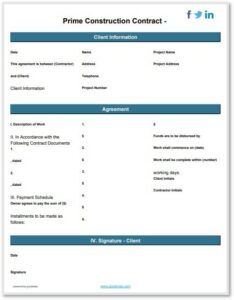
Cost Plus Fixed Fee Contract
The cost plus fixed fee contract app can be customized by the project owner or contractor, making it easy to manage all types of work and price details. Construction managers and general contractors can edit the total cost, manage the contractor price and add in their cost plus fixed fee details for the scope of work. Once the cost-plus fee contract has been completed, both parties can sign off on the details electronically.
Project Management Contract
Just about every element of a successful project in construction involves a project manager coordinating the various change orders and working directly with the general contractor to keep project team members on track with the work.
This construction project management app makes it easy to track all of the important construction contract details, including project owner contact information, general contractor name, pre-construction outline, task list, project milestones, and more.
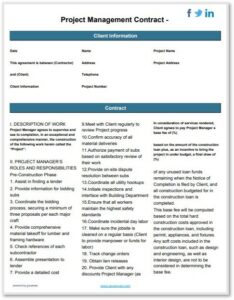
Time & Materials Contract
Similar to cost-plus contracts in construction projects, the time and materials contract template includes cost estimates and markup in the hourly labor rate in the Overhead and Profit section. In construction projects, it’s critical to stay on top of the details to ensure that projects stay within the scope of work, and in case there are questions down the road about the contract document and terms, the general contractor or the construction services provider.
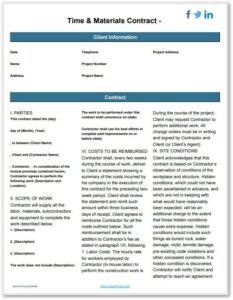
Cost-Plus Percentage Contract
Under a cost-plus construction contract, the client agrees to reimburse the contractor for the direct cost of the work, plus a percentage of all costs incurred, to cover overhead and profit. Unlike a fixed-price contract, cost-plus contracts guarantee the contractor a fair return, while allowing for various changes in the scope of work. As a construction manager, use this form to efficiently establish cost-plus pricing for long-term contracts with multiple change orders. With this design-build contract type for an agreement, use this app to best assess the estimated cost or fee according to a percentage of completion.
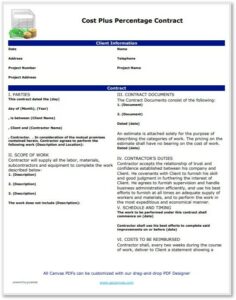
Looking for something different?
We have hundreds of pre-built forms with a variety of features to fit all of your business needs. Discover more inspections in our Application Store.

Stay in Touch!
About GoCanvas
GoCanvas® is on a mission to simplify inspections and maximize compliance. Our intuitive platform takes care of the administrative tasks, freeing our customers to focus on what truly matters – safeguarding their people, protecting their equipment, and delivering exceptional quality to their customers.
Since 2008, thousands of companies have chosen GoCanvas as their go-to partner for seamless field operations.

Check out even more resources

The Ultimate Guide to Quality Control Inspections
Managing a construction project is a complex and stressful process. Among other things, you have to coordinate project team members, materials, and equipment and ensure that contractors are not afflicted by the potential risks and hazards present at the construction site. That said, quality means different things to different people which is why you should…

Constructions Digital Transformation
Your competition is finding faster ways to capture data and get critical insights from the field into their existing systems. In short, they’re not going bigger, they’re getting smarter. In this 15-minute broadcast on the construction industry’s digital transformation, find out why the trend is to modernize workflows – and how you can stay ahead of the curve…

See how VIP Lighting optimized efficiency with GoCanvas
VIP Lighting is a retail lighting and electrical maintenance business that services over 10,000 retail locations all over Australia and New Zealand. Before GoCanvas, VIP Lighting had two separate systems that were impossible to integrate, leading to inefficiencies. GoCanvas made it easy to integrate their systems into single, centralized platform…
